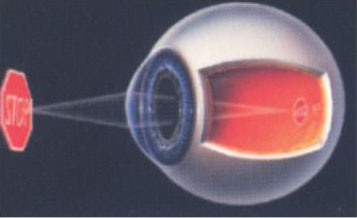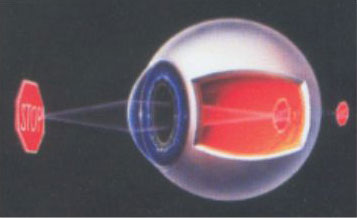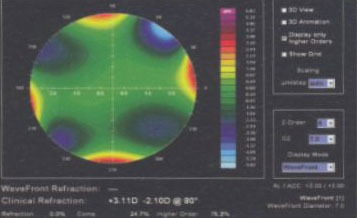A human being has different types of eye sight disorders. Young people are compelled to wear spectacles due to deficiency of vitamin ‘A’, heredity excessive exposure to computers television, and pollution. As a result, they are deprived of various opportunities like Pilot, Navy, Army, Police force and fire brigade careers, factory jobs, sales and marketing jobs, careers in entertainment industry, sports career, and girls do face obstacles in marriage proposals due to glasses.
Contact lenses gained popularity in the second half of the Last Century. However, they could only manage cosmetic part to hide one’s eye sight disorder from the other person. Recurrent expenses on contact lenses and problems owing to dust and pollution could make them just an alternative to spectacles, but not a permanent cure. Contact lenses could never fulfil the human dream of natural, healthy vision. Out of the young men and women having vision disorders, around 70% suffer from short – sightedness i.e. myopia ( -number and blurred distant vision ) while only a few of them suffer from long – sightedness i.e. hypermetropia (+number) and asymmetrical image problems (Cylindrical number and Astigmastism). After the vital task of blindness eradication, researchers and eye experts could concentrate towards the end of 20th century, which gave rise to the science of Better Vision (Refractive Surgery)
Dr. Fyoderov senior Consultant and Researcher of USSR introduced Radial Keratototny (RK), Putting Radial incisions on the peripheral part of the cornea to reduce myopia has popularized the science of better vision the Refractive Surgery. Dr. Barraquer from Bogota Columbaa was pioneer in evolving Lamellar Refractive surgery which is the plat from of today's modern Lasik Surgery.
The Excimer Laser of wave length. U.V. range totally revolutionized refractive surgery and made it safe and predictable. The precision of the out come of results in PRK Surface blation, LASIK (Laser assisted Keratomileussis in Situ) Lens based surgeries and its variants are leading modern ophthalmology in to the 21st century. To give you your dream vision – The perfect vision which always inspire us.
Normal Vision –
In normal eye, in order to see clearly, rays of light pass through the cornea, pupil & lens of the eye. A sharp & clear image is focused directly on the retina. Cornea is most powerful lens of the eye focussing. In general, eye is an camera to perceive the image and send it to the brain for analysis

Myopia (Near Sightedness)-
This is the most common type of refractive error. In a near sighted person the cornea is too steep or the eye is too long & the focal point is in front of the retina resulting in blurred distance vision. Yoy need minus numbered glasses.

Hyperopia (Far Sightedness)-
For the Far sighted person the focus of the eye is behind the retina. People who are farsighted can have trouble seeing at near and distance object you need plus powered glasses.

Astigmatism –
In this type of refractive error, shape of the cornea is not completely round but more like an egg. Light entering the eye focuses on more than one spot on the retina resulting in blurring of vision. Astigmatism can occur with near sightedness, or far sightedness. You need cylindrical glasses for your vision.

Presbyopia –
After the age of 40 years the near vision gets blurred due to aging process. You need glasses for reading and other works of near vision.

Optical Aberrations –
In few instances the irregularity incorneal surface and the optical system of the eye create irregular astigmatism and optical aberrations of the eye. Which gives you blurring of vision which can not be helped with glasses but needs wave front treatment with Laser beam.

Lasik stands for Laser assisted in situ Keratomeleussis. Lasisk is most advanced surgical procedure for the treatment of refractive errors to eliminate glasses and contact lenses. This Laser Vision correction procedure is safe painless could be done on both eyes simultaneously, takes five minutes. This uses the ‘cool’ Laser beam from the Excimer Laser to reshape the inner tissue of cornea and change the corneal power to give you freedom of Glasses Permanently. This Procedure can correct Myopia ( -20.0) to Hypersopia ( +8.0) as well as cylindrical errors up t0 6.0D.
Sai Surya Netra Houses the advanced Lasik Laser system of the world Allegretto wave ‘Blue line’ from Germany (Eye – Q 400 Htz) wave front optimized along with the wave front analysis and treatment Oculyzer the most advanced analysis and treatment profile The ‘Rondo’ Keratome flap maker altogether to give you perfect vision. The procedure is unidentifiable and can be helpful to those who want to join Army, Navy, Police etc.
The new Wave front Laser treatment is F.D.A. approved in the U.S.A. and is now even recommended by NASA for their astronauts. ‘ Sais Surya Netra Seva’ is the first center in India to have ‘Wave Light Total’ and is now official international training center for the ophthalmologist for LASIK, PHACO and other Refractive procedures. More than 50,000 Lasik surgeries have been performed here since 1994 and more than One Lack Refractive surgeries by Dr. Prakash Kankaria since 1985. ‘ Custom wave front Lasik’ out scores routine ‘LASIK’ because of perfection, precicion, least complication, and customized solution for individuals as per their demands and requirements.
LASIK is performed with the patient seated in reclining chair in an outpatient surgical suit. First the eye is numbed with a few drops of topical anaesthetic. An eyelid holder (called a speculum) is between the eyelids to keep them open & prevent you from blinking.
Basically it takes a little more time for preoperative evaluation for perfect vision and the best decision making. Spend more time for this proper preoperative assessment.
The New wave front Laser treatment gives you more perfect natural vision, which needs least post operative care and hastles.
You are eligible to undergo Lasik if
Will my number become Zero ?
The aim of the treatment is to remove dependence on glasses or contact lenses. In many cases they are eliminated.
Is Lasik Painful?
There is no pain during the surgery. Since anesthetic eye drops numb your eyes. Although some patient may experience mild discomfort or a pressure sensation during the procedure.
How long does it take to recover ?
It takes 2-3 days to recover & vision will improve there after.
When can I resume my normal activities?
Normal activities can be done after 4-5 days. However swimming & water sports can be resumed after 1 Month.
How long does the procedure take?
The surgery usually takes only 5 min.
Is the treatment permanent?
Yes. You will, however need reading glasses as you approach presbyopic age.
Will I require multiple treatments?
In order 97% of cases a single treatment is enough. In a few cases, a second’ enhancement treatments may be required to achieve optimum vision.
Can both eyes be done on the same day?
Lasik can be done both the on the same day one after another.
Is Lasik Safe?
Yes. Lasik is quiet safe & effective. But there is no surgery or surgical procedure that can guarantee perfect result. As with any surgery or medical procedure, there are possible risks. Your Doctor will give you detail information about Lasik’s potential risks, complications & side effects & you detail information about Lasik’s potential risks, complications & side effects & you should get all of your questions answered before giving your consent for surgery.